US loudspealer manufacturer Fulcrum Acoustic has announced a new partnership with Singapore-based Universal Procurement Systems (UPS) to distribute Fulcrum Acoustic products across Bangladesh, Cambodia, Fiji, Laos, Malaysia, Nepal, Papua New Guinea, the Philippines, Samoa, Singapore, Sri Lanka and Vietnam.
 Representing a stable of complementary A/V brands in the Asia-Pacific, UPS will now help strengthen Fulcrum Acoustic’s footprint across the region.
Representing a stable of complementary A/V brands in the Asia-Pacific, UPS will now help strengthen Fulcrum Acoustic’s footprint across the region.
‘We see tremendous potential for professional audio solutions in this part of the world,’ says Fulcrum Acoustic Director of International Sales, Val Gilbert. ‘As we gain traction here, having the right partner is crucial. UPS aligns with our values, and has the expertise needed to develop solutions for these markets.’
‘Fulcrum Acoustic’s innovative approach to loudspeaker and immersive technologies makes them an excellent fit for our growing pro audio portfolio,’ says UPS’ Christian Liebenberg. ‘We look forward to introducing their solutions and expanding opportunities for both companies.’
Looking for an ‘easy and stable solution’ when kitting out new Dolby Atmos rooms, Coventry University’s Music & Audio Production Course Director Benoit Granier and his team selected Audient’s Oria immersive audio interface and monitor controller.
‘It was game audio lecturer, Ben Weatherill who first spotted Oria and brought it to our attention,’ Granier says. ‘Both he and our technician/instructor in audio production Steve Birkett have been instrumental in this project. They are the real sound wizards who identified Oria’s benefits and provided the technical expertise to make it happen.’
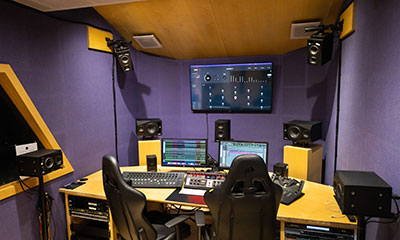 Orias are currently installed in two separate rooms; the smaller of the two runs a 7.1.4 Adam Audio loudspeaker configuration and the other a 10.1.4 Genelec configuration. ‘The Oria’s simplicity makes it user-friendly which has significantly improved our workflow and helped staff and students get started easily,’ Granier says.
Orias are currently installed in two separate rooms; the smaller of the two runs a 7.1.4 Adam Audio loudspeaker configuration and the other a 10.1.4 Genelec configuration. ‘The Oria’s simplicity makes it user-friendly which has significantly improved our workflow and helped staff and students get started easily,’ Granier says.
‘With the integration of the Dante card, it has enabled us to work seamlessly across our vast Dante studio network, integrating our current systems and hardware. We’re using them in studios that contain both PCs and Mac for game audio production, Audio Mastering and Music Production.’
A third Oria is also being used for short-term Dolby Atmos installations. This will make the most of Oria’s onboard SoundID Reference room calibration, which enables accurate measurement and calibration of multichannel set-ups in less than an hour.
Dolby Atmos is a part of all of the university’s Music & Audio Production courses that involve sound design, mixing and production, so it was important for the team to be up and running quickly. ‘Both staff and students have enjoyed using Oria, and the simplicity of the interface has made it easy for them to engage with tracking and mixing in Dolby Atmos, Granier reports.
‘The learning curve has been manageable, as both the Dolby Atmos system and Oria are designed to be user-friendly, facilitating easier adoption by staff and students,’ he continues. ‘It has allowed us to spend more time focusing on the details of mixing, mastering and sound design for Dolby Atmos, rather than focusing on the set up and configuration of the system. This has been even more important when it comes to the master’s course, the students of which have been utilising and exploring Dolby Atmos and immersive audio to an even higher level.
Describing the integration process as ‘straightforward’, Weatherill and Birkett have found much to like about the Audient Oria: ‘The standout feature is its intuitive interface, which enhances usability and accessibility for both staff and students. The Oria application is very user-friendly and makes monitoring outputs alongside adjusting settings simple,’ they say.
Coventry University has been using Audient iD4 audio interfaces for several years, and also has an ASP8024 mixing desk in one of its six music recording studios. ‘Teaching with the ASP8024 has been great, as it allows students to learn more about workflow through practical experience with an analogue desk. The layout is clean and super friendly, students are able to quickly achieve the results they want when recording,’ Granier says.
More: https://audient.com
The Les Paul Recording Studio has officially opened in Los Angeles featuring the completely restored first true multitrack recording console – The Monster – designed by Les Paul in 1957 with Rein Narma to work directly with The Octopus, the first multitrack tape machine.
Essential to the operation of the console are period-correct rectifier vacuum tubes, which were procured from the inventory at Telefunken Elektroakustik in Connecticut. Telefunken is the manufacturer of historic recreations of classic microphones alongside their own proprietary designs based around the distinctive tube mic sound.
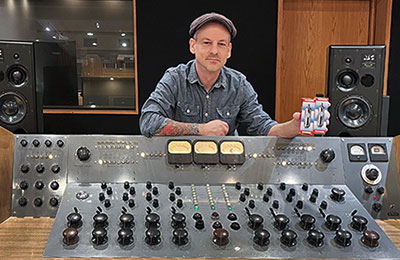 The Monster is an eight-channel, three-bus, tube console, with unique features built in, such as vibrato effects, record enabling, and tape machine control, as well as EQ and echo sends on every channel. The Monster and Octopus laid the ground the way for how music has been recorded for the past 65 years – and the foreseeable future.
The Monster is an eight-channel, three-bus, tube console, with unique features built in, such as vibrato effects, record enabling, and tape machine control, as well as EQ and echo sends on every channel. The Monster and Octopus laid the ground the way for how music has been recorded for the past 65 years – and the foreseeable future.
‘I recently oversaw the restoration of Les Paul’s original recording console and first multitrack tape machine Grammy Award-winning audio engineer Tom Camuso, now the Chief Engineer at The Les Paul Recording Studio, says. ‘After trying every tube I could find on the market, Telefunken’s new Black Diamond tubes were the only tubes that worked.’
The Black Diamond used in the console restoration is the Telefunken GZ34-TK, an accurate replacement for any amplifier using vintage GZ34 or 5AR4 rectifier tubes. Rectifier tubes were some of the very first tubes to be invented and provided an essential block to shaping the sound of an amplifier. Black Diamond Series Tubes can also be found in Telefunken’s recreations of the Fairchild 660 and 670 compressor/limiters, als invented by Rein Narma.
‘No other currently manufactured tube can handle the power draw of The Monster console,’ Camuso says. ‘I’ve been using the tubes and they’ve been working perfectly. No other new tube has lasted more than one power-up.’
The Les Paul Recording Studio commemorates the legacy of music pioneer Les Paul located at the United Recording building at 6050 Sunset Blvd in Hollywood. The studio features the restored original equipment used by the inventor and guitarist including his groundbreaking audio console and eight-track recording set up. Alongside the console sits Paul’s Ampex 5258 Sel-Sync machine affectionately called The Octopus, which is the first eight-track recorder ever produced.
Responding to online interest, Mega Audio and UNiKA Pro have announced the EMEA release of the PRO-STP, a Speaker Test unit in a compact stand-alone enclosure and featuring a Pink Noise Generator and separate NL4 and NL8 sockets to test the impedance and phase of passive loudspeaker drivers directly.
The noise generator uses a rotary level control and is accompanied by a dedicated XLR output for sending pink noise to a mixer or powered loudspeaker.
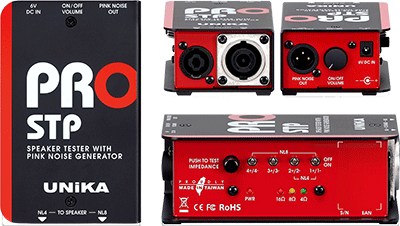 The individual pins on the NL4 and NL8 connectors are accessed by four toggle switches and a momentary Impedance Test pushbutton that sends 5V DC to the selected pins to illuminate green, yellow or red LEDs indicating impedance in the ranges 4Ω, 8Ω or 16Ω. The 5V DC button can also be used to aid visual inspection of loudspeaker cone polarity and identify polarity errors.
The individual pins on the NL4 and NL8 connectors are accessed by four toggle switches and a momentary Impedance Test pushbutton that sends 5V DC to the selected pins to illuminate green, yellow or red LEDs indicating impedance in the ranges 4Ω, 8Ω or 16Ω. The 5V DC button can also be used to aid visual inspection of loudspeaker cone polarity and identify polarity errors.
The unit requires four 1.5V AA batteries or a third-party 6V PSU.
The PRO-STP was originally designed to a special customer requirement in Asia, but has attracted significant interest from European distributors and customers and will be available from the Mega Audio warehouse in Waldlaubersheim, Germany in Q2 2025.
More: www.megaaudio.de
Promising ‘class-leading performance, reliability and value to a wide range of commercial sound applications’, Martin Audio’s Adorn A80T is aimed at applications including retail outlets, bars and restaurants, corporate offices convention centres.
‘A80T is the perfect choice for background and foreground systems which require superior performance,’ the manufacturer states. ‘Its Martin Audio signature sound characteristic also provides a seamless sonic transition within a multi-zoned complex using larger Martin Audio systems such as CDD or BlacklineX.’
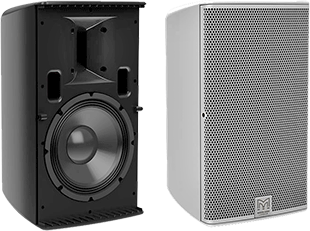 Comprising an 8-inch (203mm) LF driver and a 1-inch (25mm) polymer dome HF compression driver mounted on a 90° x 50° horn, the A80T handles 200W AES, 800W peak and can produce 120dB peak output at 1m. It has a smooth frequency response and strong bass reproduction that extends down to 63Hz.
Comprising an 8-inch (203mm) LF driver and a 1-inch (25mm) polymer dome HF compression driver mounted on a 90° x 50° horn, the A80T handles 200W AES, 800W peak and can produce 120dB peak output at 1m. It has a smooth frequency response and strong bass reproduction that extends down to 63Hz.
With a nominal impedance of 8Ω, multiple loudspeakers can be driven in parallel from a single channel of a low-impedance amplifier, maximising efficiency and minimising cost. A80T also incorporates a high-quality transformer for 70V/100V line operation, with transformer taps selected by a rotary switch. For full bandwidth protection, the low and high-frequency sections are individually protected against overload.
The Martin Audio SX112 subwoofer can be used to extend the bandwidth of the A80T for foreground music applications that require increased impact and low-frequency performance.
Available in black or white as standard, the loudspeaker can be painted to match any décor, and can be wall-mounted vertically or horizontally using the supplied WB6/8 bracket. For general outdoor use, the cabinet only requires the additional waterproof connector cover to be IP54 compliant.
More: https://martin-audio.com
Among Germany’s largest opera houses, the Leipzig Opera is setting new standards with a recent comprehensive technical modernisation that includes a high-performance Riedel system.
Planned by Graner+Partner and implemented by Sigma TBL, the opera house is now using Riedel’s MediorNet real-time media network, Artist intercom platform, and Bolero wireless intercom system for latency-free communication and flexibility in day-to-day production. A central element of the modernisation is the new Aduart stage management system, which communicates with the Riedel infrastructure via open interfaces. It comprises two main consoles, a mobile console, 28 info displays, 112 light signs, and 435 IP loudspeakers, and enables higher-level, intuitive control of the entire stage process.
At the heart of the Riedel installation is a MediorNet fiber-optic backbone, which integrates Leipzig Opera’s comprehensively renewed video system with 19 PTZ cameras. The MediorNet network ensures real-time signal transmission, de-embedding, and embedding of audio signals, as well as multiviewing. This guarantees that image and control signals for the conductor monitors arrive with virtually no latency – a decisive factor for musical performance. Thanks to MediorNet integration via NMOS and Ember+, the video system can be controlled directly via touchscreens on the stage management consoles.
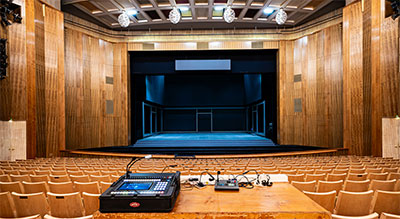 In addition, an Artist intercom ecosystem with 31 SmartPanels, 42 Bolero beltpacks, and 20 Bolero antennas was integrated to optimise the communication flow throughout the venue. Using the RRCS interface of the Artist-1024 audio matrix, and AES67, Madi and Dante protocols can now be conveniently triggered via the stage management console, for example to control individual IP loudspeakers.
In addition, an Artist intercom ecosystem with 31 SmartPanels, 42 Bolero beltpacks, and 20 Bolero antennas was integrated to optimise the communication flow throughout the venue. Using the RRCS interface of the Artist-1024 audio matrix, and AES67, Madi and Dante protocols can now be conveniently triggered via the stage management console, for example to control individual IP loudspeakers.
‘With the new infrastructure, our processes are much more efficient,’ says Oliver Gerds, Leipzig Opera Technical Director. ‘The seamless communication, the flexible routing of audio and video signals, and the ability to control everything in real time offer enormous advantages in our day-to-day operations.’
‘The close cooperation with Graner+Partner and Sigma TBL has allowed us to develop a tailor-made system that significantly increases both work safety and efficiency,’ says Riedel Communications Sales Manager, Bernhard Bauer. ‘This installation ensures that the traditional opera house is ideally equipped to meet all the challenges of future productions.’
More: www.riedel.net
Multi-platinum and Grammy-winning mix engineer Richard Furch has called on Carl Tatz Design (CTD) to create a PhantomFocus Dolby Atmos MixRoom at his Los Angeles home. Named mixManor Studios, the resulting facility embodies Furch’s vision of minimalism, acoustic precision and seamless workflow.
As with all CTD MixRooms, the acoustic design of mixManor Studios is dictated by the proprietary PhantomFocus Monitor System. The 9.1.4 Dolby Atmos MixRoom features a total of 13 PFM Master Reference Monitors, including 11 PFM UHD-1000p Mk II passive monitors for surrounds, and two PFM UHD-1000a Mk II active monitors for the left and right channels, providing a powerful and precise immersive monitoring environment.
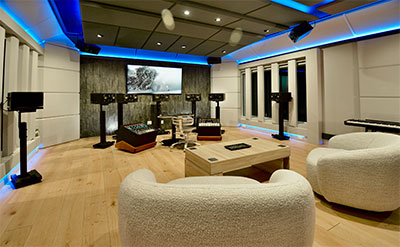 The studio is designed with both functionality and aesthetics in mind. One of CTD’s acoustic design signatures is the Acoustic Lens modules on either side of the mix position, in this instance allowing an abundance of natural light to flood through a window behind the lens columns on one side, and then mirroring that on the other, giving both acoustic diffusion/absorption and visual symmetry. Adjustable luminance is achieved by employing a remote-controlled translucent shade. Another CTD immersive room feature is the motorised centre monitor lift, which enables smooth transitions between stereo and Atmos mixing modes at the push of a button. Other MixRoom features are the Axial Mode Absorber, PhantomFocus eChair, PF Monitor Stands and CTD custom acoustic modules by Auralex.
The studio is designed with both functionality and aesthetics in mind. One of CTD’s acoustic design signatures is the Acoustic Lens modules on either side of the mix position, in this instance allowing an abundance of natural light to flood through a window behind the lens columns on one side, and then mirroring that on the other, giving both acoustic diffusion/absorption and visual symmetry. Adjustable luminance is achieved by employing a remote-controlled translucent shade. Another CTD immersive room feature is the motorised centre monitor lift, which enables smooth transitions between stereo and Atmos mixing modes at the push of a button. Other MixRoom features are the Axial Mode Absorber, PhantomFocus eChair, PF Monitor Stands and CTD custom acoustic modules by Auralex.
Beyond the mix environment, mixManor Studios offers a boutique experience for clients. A kitchenette, adorned with Furch’s numerous industry accolades, provides a welcoming space, while a dedicated booth area is available for occasional overdubs. A carefully curated selection of outboard gear and plug-ins enhances the studio’s flexibility and creative potential.
Furch’s approach to studio workflow eschews the traditional mixing console in favour of a small pedestal desk that accommodates a keypad and monitor controller. This eliminates unwanted reflective surfaces and offers a clean, uncluttered workspace. All wiring is concealed within floor troughs leading to a separate machine room, further enhancing the room’s streamlined look and feel.
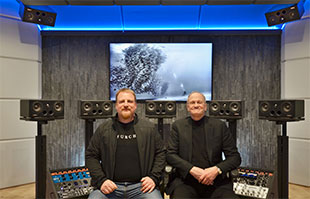 To complete the space, mixManor Studios is equipped with colour-changing LED lighting, allowing for multiple programmable scenes that contribute to the studio’s immersive atmosphere. The result is a one-of-a-kind facility in the heart of LA, tailored to the highest standards of modern audio production.
To complete the space, mixManor Studios is equipped with colour-changing LED lighting, allowing for multiple programmable scenes that contribute to the studio’s immersive atmosphere. The result is a one-of-a-kind facility in the heart of LA, tailored to the highest standards of modern audio production.
‘We installed a PhantomFocus System for Richard in his previous mixHaus facility over a decade ago, and have become friends during that time, sharing a lot of the same views on audio and design aesthetics – and The Musso & Frank Grill. When he decided that he wanted to be closer to home and family in his work, CTD was able to offer perspective in choosing a new house in which we would implement a PhantomFocus MixRoom. There were several iterations during this time until he found the right house. Richard had definite ideas about how he wanted the room to look and feel within the parameters of a CTD MixRoom, which made it sometimes challenging but, in the end, quite rewarding once solutions were found and both of us could not be happier with the results,’ comments Tatz.
‘After mixing chart-topping records on a PhantomFocus system for the past 14 years, I knew I wanted Carl to design my new mixManor Studios from the ground up,’ Furch says. ‘Starting with a space that allowed us to build optimal acoustic dimensions for a large, bright room with daylight and modern lighting design through a full room-in-room concept for excellent isolation to the outside, this space is surpassing all my expectations. The custom PFM UHD-1000 Mk II monitor system for stereo and full 9.1.4 Atmos is fully integrated into the design, delivering sonic excellence throughout, with exceptional translation and accurate frequency response all the way down to 25Hz. A feast for the ears and the minimalist eyes, it is a pleasure to continue my work in a space of this calibre and surroundings that make me want to create music daily. Thank you, Carl and Adam [Adam David Smith, lead PhantomFocus installation engineer] for the incredible experience and friendship.’
More: www.phantomfocus.com
Genelec has strengthened its global distribution network with the appointment of Geovoice to handle the distribution of its professional audio monitoring, installed sound and home audio ranges in the nation of Georgia.
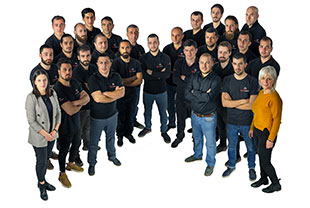 Founded in 2004 and based in Tbilisi, Geovoice is the leading professional audio distributor in the Caucasus region, with a partner-based approach built around trust and collaboration.
Founded in 2004 and based in Tbilisi, Geovoice is the leading professional audio distributor in the Caucasus region, with a partner-based approach built around trust and collaboration.
Having developed a strong network of local relationships supported by an experienced, highly qualified team, Geovoice provides superior levels of service tailored to the specific needs of its local market.
Geovoice also prioritises the importance of relationships with manufacturers that align with its local business model, and who are responsive to the priorities of the region. The company believes that the key to success lies in collaboration with manufacturers who understand the intricacies of the Caucasus, and offer technology that meets the requirements of local customers.
‘The Genelec brand has become synonymous with innovation and excellence in professional audio and installed sound,’ says Geovoice CEO, Lasha Matitaishvili. ‘Genelec’s extensive range of solutions presents a significant opportunity for growth, not just for Geovoice, but for all our partners in the region. Together, we have the potential to deliver cutting-edge solutions to our clients and achieve mutual benefits in a rapidly evolving market.’
‘Geovoice was chosen for its deep expertise in professional audio, strong market presence, and commitment to delivering exceptional customer service,’ adds Genelec International Sales Manager for SE Asia, Eastern Europe and Canada, Steen Tychsen. ‘The company’s knowledge of the industry and dedication to quality aligns perfectly with Genelec’s values, ensuring our solutions are supported by a trusted and capable partner. We are excited to welcome Geovoice as our new distributor for Georgia, and we look forward to working together to bring the finest sound to our customers there.’
Powersoft’s ArmoníaPlus 2.8 release promises ‘a major update packed with usability enhancements, making operations more efficient and intuitive’. The update introduces support for Powersoft’s latest Unica 8T and Unica 4T touring amplifiers, with multiple quality-of-life improvements designed to accelerate large-scale system configuration via workspace.
ArmoníaPlus 2.8 system management software refines system design, tuning and device management, as well as enhanced group assignment for faster visualisation; when a loudspeaker is selected, its associated group names are highlighted in blue. This makes navigating between elements and verifying assignments in the system quicker.
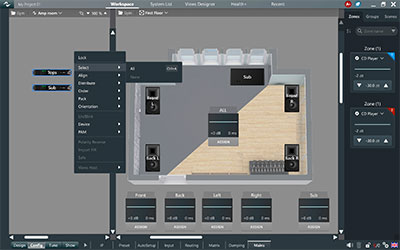 The new right-click Replace With… function allows users to swap devices without manual reconfiguration, while the new device inherits all DSP, network, and Dante settings from the replaced unit. The update also provides users with configuration and preset enhancements, making it more intuitive.
The new right-click Replace With… function allows users to swap devices without manual reconfiguration, while the new device inherits all DSP, network, and Dante settings from the replaced unit. The update also provides users with configuration and preset enhancements, making it more intuitive.
With the update, the applied preset displays directly on loudspeakers, and users can edit preset application and manufacturer’s EQ categories across multiple speakers simultaneously, even if model is not exactly matching, provided they share the same configuration options.
ArmoníaPlus 2.8 also introduces a new Channel Strip Mode, unifying multiple tuning functions, such as Gain, Mute, EQ, Delay and Polarity,. The Mute and Solo pages have been combined into a single Mute/Solo page, with Solo mode offering both Exclusive and Additive options.
Other features included in this update are display read-only mode for Unica series, to enhance security in unattended systems, bug fixes to increase the stability of the communication protocol in busy network scenarios. Improved device selection and power manager enable users to quickly power devices on/off or manage eco-mode settings without leaving the workspace. As well as workflow simplifications, with the removed Show step and relocated impedance monitoring to the new Tune step.
More: www.powersoft.com
Alfatron Electronics has introduced the MA15075D Compact Digital Mixing Amplifier, targeting commercial installed sound environments in low or high impedance applications in a compact 1U-high form factor.
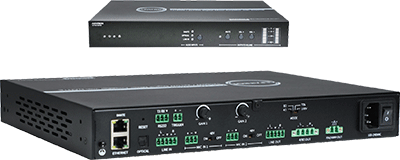 The unit is a class-D amplifier with a mode selector switch that enables it to deliver either two channels of audio at 75W/channel into 4Ω or 8 Ω loudspeakers, or a single channel of 150W at 70V or 100V for use with distributed systems. It provides a balanced line level output that enables the mixed audio to be sent to an additional amplifier or other audio system, such as in an adjacent room.
The unit is a class-D amplifier with a mode selector switch that enables it to deliver either two channels of audio at 75W/channel into 4Ω or 8 Ω loudspeakers, or a single channel of 150W at 70V or 100V for use with distributed systems. It provides a balanced line level output that enables the mixed audio to be sent to an additional amplifier or other audio system, such as in an adjacent room.
In addition to two Dante audio inputs and one optical audio input, the unit carries a stereo balanced analogue input and two balanced microphone inputs on Euroblock connectors. It provides two balanced line level outputs, a stereo Low Impedance amp output, and one 70V/100V amplifier output.
The audio sampling rate is 48kHz at 24-bits, and there are two rear panel input level controls for setting the input gain of the two microphones inputs. The amplifier also offers automatic standby after a period of inactivity to minimise power consumption as well as low inrush current to prevent audible ‘thumps’ when multiple amplifiers are powered up simultaneously. The MA15075D also incorporates integrated DSP five-band graphic equalisation.
For intuitive control and operation, there is a GUI web server with TCP/IP control for remote control or third-party integration. A rear panel trigger port provides external mute/ unmute capability. To further ensure easy operation, the MA15075D’s front panel includes signal status LEDs for power, a panel button lock, audio source indicators, a mute switch, and real-time level meters.
‘The MA15075D ushers in a new era for our amplification range,’ says Alfatron Electronics National Sales Director, Kevin Gelman.’It is feature rich, compact, and provides versatility and easy integration with a variety of input options, including Dante audio networking. Furthermore, the built-in GUI webserver allows for easy configuration and control without the need to use additional software. We are confident that the MA15075D, paired with our Alfatron speaker range, will fit our clients’ solution requirements and provide exceptional sound quality for the user, whether it be for background music, conferencing or other similar applications.’
Cardiff-based theatre and live event rental company Stage Sound Services (SSS) has made a ‘future-proof investment’ in DirectOut solutions for theatre assignments
‘We’ve been using DirectOut Technologies’ kit since 2013 when we bought the original Andiamo Madi Analog converter,’ Huw Semmens says. ‘Following that initial investment, whenever we had a specific task that required a hardware solution, we found that DirectOut already had a suitable product in their line-up. We now have just under 100 DirectOut assets in our inventory, including ExBox.MD, Ma2chbox.XL, Madi.ridge, Madi.9648, Andiamo2, Andiamo.AES, Split.Converter, and the recent Prodigy.MP and Prodigy.MX.’
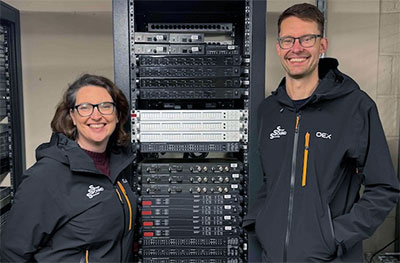 Having the shelves full of equipment that is used once and never again represents a wasted investment for a hire company, not being cost-effective in terms of rental returns or storage space. If a designer requests equipment that is not in the company’s regular rotation, it is down to Semmens and his team to ensure that the product is viable and cost-effective for the company, without disappointing the designer.
Having the shelves full of equipment that is used once and never again represents a wasted investment for a hire company, not being cost-effective in terms of rental returns or storage space. If a designer requests equipment that is not in the company’s regular rotation, it is down to Semmens and his team to ensure that the product is viable and cost-effective for the company, without disappointing the designer.
‘First, we will look at our existing inventory to check whether we carry something that’s able to achieve the same result,’ he explains. ‘If that isn’t possible, or the solution is too convoluted, we’ll establish potential future usability of this new item before deciding whether to invest. Solutions such as DirectOut’s Prodigy can replace several separate pieces of equipment, so for an application such as converting Madi streams to Dante and functioning as a patch bay for digital radio mics, it makes complete sense to invest.’
The change to digital radio mics in theatrical performances has had a knock-on effect for SSS. Theatrical performances usually follow a full schedule of shows, generally eight shows over six days a week, as two days also have matinee performances. This means that sickness or injury is likely to affect the performers’ ability to appear. When this happens, especially in musical theatres, an understudy covers the role. It is unusual for them to only cover one role, especially if there is a chorus, as understudies and swings usually have chorus roles to complete, too. The easiest way to get around this is to patch the mics as the performers switch roles throughout the show. In analogue systems, this could be via a bantam patch panel, or directly using XLR.
However, with the proliferation of digital transmitters and receivers, production sound engineers are looking for more accessible options: ‘A huge surge towards digital radio mics in theatre over the past five years has meant ExBox.MD, alongside globcon has been used in place of bantam patch bays for radio mic monitoring and patching,’ Semmens says. ‘Similarly, more shows are moving towards 96kHz systems. With band monitoring hardware generally operating at 48kHz, we have deployed the Madi.9648 as a bridge between these systems.’
The Prodigy Series is a range of solutions that have been designed to address numerous applications across live, broadcast, installation and recorded sound industries. It is this flexibility that has been most attractive to SSS and resulted in their continued use of the full range of products.
‘The modular nature of Prodigy is perfect for us as a rental company because it allows us to carry one or two types of host unit (MP and MX in our case) and a selection of I/O cards to cover most conversion requests,’ Semmens says. ‘Software/plug-in upgrades are also optional and granular, so we’ve been able to customize the specs of the units, adding Automator and OSC add-ons in our case, to ensure they’re exactly what we need.’
DirectOut prides itself on delivering bespoke solutions and Prodigy.MX, .MC and .MP can be tailored to deliver unique solutions to a range of applications. Combining DirectOut Products with third-party equipment to provide even greater flexibility, reliability and control, especially important in the ever-changing world of theatre.
‘The vast array of modules and control protocols available introduce so many possibilities. We have a couple of productions using Nemesis Research OSCA-1616IO to OSC convert button presses, controlled by a custom-built button panel, switching an alternative mic input into the console. Sonoros audio routing software is about to integrate control of DirectOut hardware so that pre-defined macros can be used to reroute audio, too.’
When your customers are as diverse as the client list of SSS, reliability and support are key concerns: ‘On the odd occasion that we’ve had reason to reach out for support, both our supplier, Aspen Media, and DirectOut themselves have been great, responding rapidly to our requests and resolving our issues,’ Semmens says. ‘We have a few Prodigy.MP on shows at the moment. I suspect our DirectOut products will be used for many years to come, and I never have any hesitation in recommending them. The reliability of DirectOut’s kit is second to none.’
More: www.directout.eu
Fast-and-Wide Blog
-
Music and Obsolescence: An Index of PossibilitiesAs a Tyrell Corporation Nexus-6 replicant, Blade Runner’s Roy Batty had a predetermined life span of just four years – and he wanted it extended. Remonstrations...Read More...
-
Our Infatuation with SaturationWhen professional digital audio made its entrance, the limitations of early technology combined with the excitement of some advocates made it a soft target...Read More...
-
Controlling InterestThe very first synthesiser I owned was a Moog. And my second; and my third. I still have two of them, a Micromoog and Minimoog, but sold the third, an...Read More...
-
Sport in Absentia: The Sound of the CrowdSo sport is back, in part, but fans are presently unwelcome at the matches being played – unless you count the cut-outs that the likes of Brighton &...Read More...
-
The Last Seat in the HouseWe were just a few days into the UK coronavirus lockdown, when a copy of The Last Seat in the House: The Story of Hanley Sound arrived on my doorstep....Read More...
-
Knocking Back CoronaWith only 13 countries presently likely to be remaining Covid-19 free, the live music and club industries worldwide have taken a heavy blow. The games...Read More...
-
Après MidiWhen it appeared in 1983, Midi changed my life – as it did for countless other keyboard players around the world. Like any revolution worthy of...Read More...
-
evolution: Sennheiser’s revolution Pt.2Having explored the thinking and story behind the evolution concept, Sennheiser’s exclusive show-and-tell session in London gave the floor to the a handful...Read More...
-
evolution: Sennheiser’s revolution Pt.1‘Twenty years ago, a question was posed: should Sennheiser continue to produce dynamic microphones? Our prices had gone up and our profit had gone down...Read More...
-
The Pink Floyd Exhibition: Their Mortal RemainsReleased in March 1967, ‘Arnold Layne’ was the first of eight singles from the fledgling Pink Floyd that year. Fifty years on, and with an unassailable...Read More...
-
Making Waves: Cause and Effect in Kit ReviewsSharing time and a couple of bottles of Asahi with another former pro audio magazine editor in the bar of London’s Metropolis Studios recently, the...Read More...
-
The Heydays of PhaseSometime around 1975-76 I wanted an MXR Phase 90 for my Wurlitzer electric piano – I wanted what the ‘real’ keyboard players of the time were using....Read More...
-
The Vibe RevivalWith the ambition of the first Leslie emulation pedals finally fulfilled, the story of the Shin-ei Uni-Vibe has come full circle. In its wake we have phasers,...Read More...
-
Second Screen Sports: Off Tube, On TargetMy local pub has a split personality. Or, maybe, it’s more like a secret identity – a single location but with two roles in life. For some of us,...Read More...
-
Sound of Story: Chapter 3I once read that smell is our strongest associative sense. I’ve since tried to establish the relative ability of our other senses to evoke memories...Read More...
-
Flange Theory: How I Miss My MistressIt seems to have become a common misconception that guitar fuzz boxes and distortion pedals predate more eloquent effects, such as phasing and flanging. OK,...Read More...
- 1
- 2
- 3
- 4
- 5
- 6
- 7
- 8
- 9
- 10
- 11
- 12
- 13
- 14
- 15
- 16
- 17
- 18
- 19
- 20


